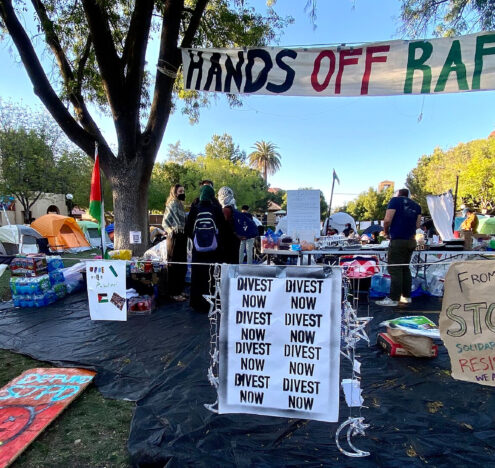In a 2018 research report by the Brookings Institution, Darrell West and John Allen wrote that, “Despite its widespread lack of familiarity, AI is a technology that is transforming every walk of life.” If five years ago AI, the idea of which dates back to the previous century, was already transforming “every walk of life,” then today this transformation can be felt in our daily routines more than ever. AI-powered and AI-driven smart home devices, autonomous vehicles, speech recognition technologies, virtual assistants, and ChatGPT are ever present.
Unsurprisingly, militaries around the world are racing to utilize artificial intelligence to boost military capabilities and improve the efficiency of existing technologies. In doing so, they are unleashing a powerful chain reaction that is bound to have serious implications for the conduct of warfare and the future of conflict. A case in point: drones.
A Different Kind of Weapon
As with other industries, drone manufacturers are embracing the revolutionary innovations introduced by artificial intelligence. Drones or Unmanned Aerial Vehicles (UAV) have now become one of the most commonly used and sought-after weapons for states. The military drone market is expected to surpass $100 billion by 2032, while international demand for these relatively cheap and increasingly effective weapons is increasing exponentially. Their popularity is growing even more given their game-changing role and successful applications in recent wars, as demonstrated by Azerbaijan’s widespread use of them in the 2020 war over disputed Nagorno-Karabakh and their role in Russia’s war in Ukraine today.
Although drones have been developed and used for decades, starting with attempts to create a remote-controlled aircraft during World War I and America’s use of surveillance drones during the Vietnam War, they have been seen as a force multiplier and auxiliary support to air and missile warfare, not a primary tool for offense. With recent technological breakthroughs, this is changing.
AI is making the data and sensor fusion analysis of drones significantly more effective, allowing complex algorithms and machine learning to create a far better understanding of the drone’s surrounding environment. It is improving the communication systems and cybersecurity of critical data obtained, interpreted, analyzed, and transmitted by drones.
Regulating Killer Robots
But artificial intelligence is not simply introducing a range of advancements that are boosting the effectiveness of drones and helping overcome their current technological limitations. AI is transforming them into a fundamentally different kind of weapon. The two revolutionary innovations that AI is currently spearheading in drones are swarm intelligence and automation.
Swarm intelligence is a concept within AI and computer science referring to the study of “decentralized, self-organized systems, natural or artificial.” The origin of this concept dates back to a 1992 study by Marco Dorigo, ant colony optimization, in which Dorigo’s observation of the social behavior of ants led to the development of algorithms that allow an optimized interaction between the individual agents of the whole system.
What this means in drones is that AI is allowing UAVs to function in a coordinated and coherent manner in a “swarm” which allows a military to launch a barrage of drones in an offensive capacity. A carefully planned and executed swarm drone attack can overwhelm the enemy and perform tactical and strategically important military tasks, thus further increasing a drone’s individual usefulness.
Add automation to the equation, and the results look like scenes from a sci-fi movie. AI-powered automation is poised to become the most transformative emerging technology to revolutionize UAVs for military use. What was once an imaginary concept is already becoming the new way of warfare, producing a new kind of lethal weapons which are now known as “killer robots” or Lethal Autonomous Weapons Systems (LAWS) which can be ground-based, air-based, or water-based.
What sounds like a horror movie scenario of killer robots acting in unison during an attack could soon be a reality.
The introduction of AI automation into UAVs is already producing advancements in several areas of drone operations, including in autonomous navigation, communication networks, data analysis, integration with the Internet of Things (IoT), and lastly autonomous decision-making for offensive operations. Autonomous decision-making is by far the most controversial feature, and the lack of any international regulations or cooperation between states to regulate the norms of production or use of such weapons is already alarming human rights groups and advocates of ethical warfare. Human Rights Watch, for example, calls for a “preemptive ban on the development, production, and use of fully autonomous weapons.”
As of 2023, several countries are already in the race to harness the power of automation in drones, including the United States where the Valkyrie experimental aircraft, for example, is being developed as the first prototype of drones entirely run by artificial intelligence. Automation is already in play in the conflict in Ukraine where Russia is alleged to have used AI-enabled Kalashnikov ZALA Aero KUB-BLA loitering munitions. The race to perfect killer bots is also becoming the next area of competition between the United States and China, reminiscent of the Cold War arms race.
These two capabilities combined will turn drones from auxiliary, support devices into strategic weapons that states will turn into large arsenals given their relatively cheap cost and significant potential as a force multiplier. With the coming capacity to launch autonomous aircraft able to act collectively in a swarm, and drones with the autonomous capability to select a target and launch a strike, what sounds like a horror movie scenario of killer robots acting in unison during an attack could soon be a reality.
Questions related to the international regulation of LAWS and killer robots — or the lackthereof — will determine the new norms of warfighting in the coming age of uncertainty and tense geopolitical competition. This very recognition is bound to push states into a self-perpetuating security dilemma of either developing these weapons and acquiring them or running the risk of losing their relative military capability vis-a-vis friends and foes alike. What states choose today and how they will direct the evolution of AI norms in drones will impact the shape of wars to come.





















